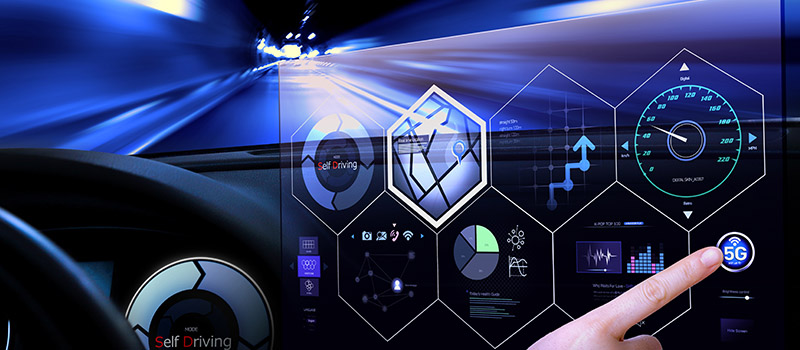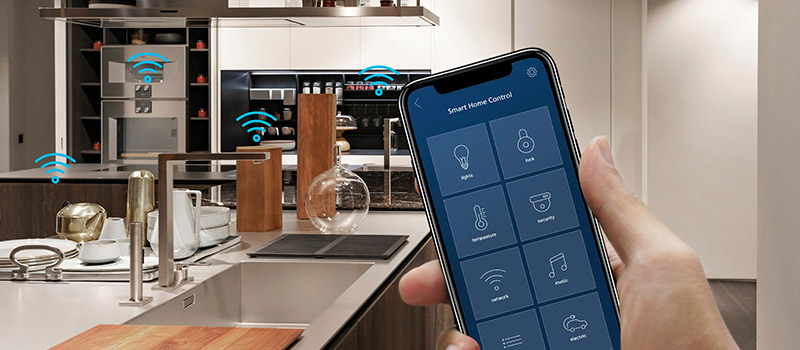Could you imagine living in a world where your home, car, and even your most basic devices are all connected and cooperating to make your life easier? This is the exciting promise of ambient computing — an emerging technology that integrates smart devices and sensors into our physical environment to create a seamless network of interconnected technology without much human intervention. Yet as we embrace this new era of technology, a pressing concern looms on the horizon: the "autonomy trap". What happens when we cede too much control to such devices, and they start making decisions for us? It's a complex issue that raises important questions about the balance between convenience and control, and the responsibility we bear in shaping the future of technology.

Picture this: It’s Friday morning. You wake up to the sound of your alarm but instead of reaching over to turn it off, your smart home does it for you when it senses you are fully awake. Your coffee is already brewing and your smart thermostat has set the temperature in your home just as you like it. As you are getting ready, your smart mirror displays your schedule for the day, along with the weather forecast and news updates, and suggests an outfit based on that data. Meanwhile your wardrobe opens obligingly as you pause in front of it. As you step out of your home, the system automatically locks the doors, secures the windows and switches on the alarm system as you walk to your car, which is ready and waiting to drive you to your workplace. When you get to work, the smart system in the office senses you walking to your desk and promptly issues an alert about an urgent email that requires your attention. The system has already read the email in question, summarised the key points, highlighted the action items and then suggests the optimal response based on your previous communication style and the context of the message.
Today also happens to be grocery day, and you are excited because you love going to the store, getting what you need and simply walking out the door. At the exit, the system simply detects all the items in the shopping trolley and automatically deducts the total amount from your account. Although you’ve been doing this for a while now, you still can’t get enough of this smooth shopping experience. However, as the day goes on, one of your friends posts a message in a group chat. It is Friday and he wants to know if you’re up for a cool beer and a barbecue at his place that evening. All of your friends are up for it, which is a miracle given that you’re all always super busy. Of course, you’d like to go too — however, that will mean that you won’t actually have time to do your grocery shopping after all. When your phone automatically adds the barbecue party to your calendar, your smart fridge at home notices, triggers an action and sends you an alert: while you are busy at work, it has automatically composed a shopping list based on your typical food consumption and preferences, and sent an order for delivery to the local supermarket with the lowest prices, so your items will already be waiting for you at your door by the time you get home. The fridge also lets you know that it has ordered a few beers and some sausages so you don’t show up empty handed for the party. As you get home, the front door recognizes you, unlocks itself and adjusts the lighting and the windows to your preferences and the current weather.
After you have taken a shower, with the water temperature and pressure automatically adjusted perfectly to your preferences, your smart mirror, once again, suggests an outfit for the party. It’s time to head over to your friend’s house. You won’t have to worry about drinking too much: your smart watch will detect when you’ve had enough and send you an alert so that you can head home. Your car automatically takes you there. When you arrive home again, you’re not really sleepy yet, so you decide to catch up on some reading. Your e-reader has already curated a personalised reading list based on your interests, previous reading history, and recommendations from other users. As the day comes to an end, your ambient intelligence system reminds you to wind down and get ready for bed. The system turns off all unnecessary devices, turns off the lighting, draws the curtains and plays soothing music to help you relax.
This is the world of ambient intelligence, where invisible technology seamlessly integrates into daily life to make it more efficient and comfortable. From smart homes to personalised healthcare, the possibilities are endless.
What is ambient intelligence?
Ambient intelligence, or ambient computing is a revolutionary concept in which different technologies — such as Artificial Intelligence, Edge Computing, Natural Language Processing, Wireless Mesh network and Machine Learning — collaborate through a variety of smart devices to produce a more convenient atmosphere with no need for human intervention. It involves moving away from rigid, predetermined workflows, control scripts, and operational procedures and instead focuses on enabling subtle, synchronised, and mutually beneficial computer actions alongside daily life, perfectly fitting and adjusted to the individual circumstances of its user. Technology is embedded in everyday working and living environments, creating an invisible and unobtrusive presence that responds to voice and gestures, providing personalised experiences based on our previous decisions and behaviours. By integrating smart devices and sensors into our environment, the boundary between digital and physical worlds blurs, creating an intuitive and supportive partner system in everyday life.

All of the examples above give us a glimpse of what this future might look like, and they also indicate that such a future is not even very far away. The Amazon Go stores already provide a Just Walk Out function providing a shopping experience precisely as described in the example above. There are smart mirrors that give you a helping hand in picking out outfits: some let you try on clothes, others scan your body type to work out your height, leg length, waist size and more, then recommend clothes that will suit your measurements and overall style. Smart refrigerators have functions and screens for you to order groceries, or even browse recipes, and it has been reported that Amazon started working on a fridge that actually does order the groceries for you back in 2021! Gmail has smart reply and smart compose functions to help you email more efficiently. As you can see, there are already a lot of individual examples that either exist or are due to arrive in the near future. The one thing that’s really missing for the example to become a reality rather than a script for a Black Mirror episode, is the interoperability, that is, communication between all the various devices and systems. This would create a unified system where everything works in tandem, making daily life significantly more convenient. But even that may not be as far off as you might think. According to the 2023 Ambient Intelligence Market Report, market size for global ambient intelligence was valued at USD 18.44 billion in 2022 and is anticipated to grow at a compound annual growth rate (CAGR) of 24.4% between 2023 and 2030.
Potentially, ambient intelligence could provide numerous benefits in various areas of life. Wearable technology can be used to enhance our wellbeing by monitoring exercise and health levels, making recommendations based on the data collected to enable users to lead healthier and more balanced lives. In the workplace, ambient computing can automate repetitive tasks, improve productivity, and provide real-time information, making work more efficient. In healthcare, ambient computing can help diagnose and treat patients in diverse settings, including the home, freeing up space in hospitals. Insurance companies could introduce dynamic insurance rates that are based on actual behaviours, allowing for more precise calculations of risk. For instance, a smart car could provide insurers with detailed information about the driving habits of its owner, and the car insurance premium could be adjusted accordingly.
“The Dark Side of the Moon New”
With all this convenience, ambient intelligence is — as most emerging technologies are — also a two-edged sword. On the one hand, it could increase our comfort level and enhance our control over the environment by making it more responsive to our needs, but on the other hand, it could potentially erode our autonomy and free will by fully delegating decision-making to machines.

There is a risk that we may become overly reliant on technology and lose the ability to think critically and make decisions independently. It is especially problematic considering that — as the rise of deep fakes has shown — in a world where AI can generate highly convincing images and other life-like content, it’s more important than ever to maintain our critical thinking skills. Studies have shown that critical thinking has been one of the tools used in daily life to deal with challenges to our survival, and it reduces the susceptability of individuals to manipulation. If we stop questioning things and blindly accept the decisions of ambient systems, we may unwittingly fall into an autonomy trap, where we believe we’re making our own decisions when in fact computers are actually making them for us.
This concern is even heightened in the case of potential misuse of data by external companies who may have a vested interest in influencing our decisions for their own profit. My online behaviour may lead profiling software, for instance, to predict that I am considering switching from a car to a motorcycle . Based on my activities, the program could predict that there is a 90% chance that I will make the transition in the near future and then sell that information to a car manufacturer or dealership with an interest in my continuing to be a car owner. The buyer of this information may then send me personalised advertisements showcasing the latest car models, emphasising their safety features, spacious interiors, and fuel efficiency. They may also offer me test drives or exclusive deals on car purchases to further entice me to stick with cars instead of switching to a motorcycle. The profiling program might have calculated that such targeted marketing efforts would decrease my chances of switching to a motorcycle by 20%, justifying the investment made by the car company.
In the realm of sports and fitness, ambient intelligence holds great promise, yet it also harbours the potential for misuse, posing some serious risks. Consider a scenario in which the creator of an ambient intelligence system integrated into my smart fridge is influenced by a company operating a chain of gyms in my area. In this situation, my fridge could subtly encourage me to select food and beverages with higher calorie and carbohydrate content, thereby incentivizing me to frequent the gym more often to shed the extra weight I would inevitably gain, ultimately benefiting their membership revenue. Meanwhile, I would be unaware of the entire process.
The potential for data breaches and privacy violations are additional risks associated with ambient computing devices. If these devices are constantly collecting data about us, there is a risk that this data could be misused or exploited. This could lead to a loss of privacy and security, which could further erode our autonomy and decision-making, not to mention the risk of the behavioural data being exploited for criminal activities. As our devices collect more data about us, the risk that this data could be misused or exploited is also heightened, leading to consequences and decisions that are not in our own best interest.
Addressing the concerns
Undoubtedly, addressing these concerns and being proactive is critical, since simply halting innovation and technological advancement is not a viable solution, nor even likely to be possible. A recent example highlights this point well. A couple of months ago Elon Musk, along with other tech leaders and AI experts, made the headlines worldwide when he proposed a six-month pause on large-scale AI experiments in order to allow sufficient time for the development of safety protocols, AI governance systems, and to refocus research on ensuring AI systems are more accurate, safe, “trustworthy and loyal”. However, this proposal sparked a significant debate among experts and the general public, with many experts arguing against the pause and even labelling it as a “terrible idea“. Nevertheless, finding a balance and working solutions to address these matters before they become actual problems is vital, especially for a technology that is so fundamentally built on trust. We need to establish ethical guidelines and regulations to ensure that ambient intelligence benefits humanity rather than putting our autonomy and free will at risk.

User Input
One strategy to strike a balance between autonomy and user control is to ensure that ambient computing devices provide their users with sufficient input and control over their operation. This can be achieved by incorporating user preferences and settings that allow us to establish restrictions and parameters for the device’s behaviour. That way we could basically set our own preferred level of ‘control surrender’.
Built-in Clear Feedback and request for revision
Another way to avoid falling into the autonomy trap is to provide clear feedback to us on the activities and decisions of ambient computing devices concerning our lives with regular built-in warnings to revise our control preferences indicating and explaining the level of autonomy that we still hold. If a device makes a decision that contradicts our preferences, it should provide a clear explanation of why that decision was made, and we should be able to override it if necessary.
Manual Control
While autonomous devices are supposed to run without input, the provision of manual control alternatives in the event of an emergency or when the device’s actions may have unexpected repercussions is critical. This can be accomplished by incorporating manual controls or emergency shut-off switches that allow us to take control over the gadget should we need to.
Prioritize open-source technology
One solution is to prioritise open-source technology that allows us to customise and control our devices. By using open-source software, we can avoid being locked into a specific ecosystem and maintain control over our data.
Transparency & strong privacy protections
Companies that collect and use our data should be transparent about their practices and be held accountable for any misuse. This would help to protect our autonomy and ensure that the decisions we make are based on our own preferences and values.
However, while these solutions, and many other ideas surrounding ambient intelligence seem logical, translating them into action and regulations is not so straightforward for a variety of reasons. Despite the importance of regulating new technologies, the process can be slow and complicated. Organisational inertia is one significant barrier. Justifying the allocation of resources to a threat that does not yet exist when we are struggling to keep up with our current tasks is a challenge. Additionally, the complexity of the technology itself creates further difficulties: the people who are responsible for protecting society from threats, such as law enforcement officers and legislators, lack the field-specific expertise to make these types of predictions. And these issues are not unique to ambient intelligence but apply to virtually any complex and new technology. The possible ways of tackling the problem are just as complex and pioneering as the technologies themselves and warrant a separate discussion – stay tuned for that!
Innovation society maturity
As we wait for regulations to catch up with the pace of innovation, the responsibility for interacting safely with ambient computing devices falls on the individual. However, rather than fearing the potential dangers, we need to see the whole picture and realise that this is not so very different from what humans have done repeatedly throughout history, and that the future is actually not nearly as dark as some would paint it.

Let’s consider the decisions we would actually relinquish to ambient intelligence. In most cases, these decisions are minor and ultimately inconsequential. For example, choosing which brand of cereal to buy or what music to listen to are not significant decisions that define our lives. Such decisions may, however, have a substantial impact on an artist or a cereal company if made collectively by many individuals — which brings us back to the tools required to tackle the misuse of the technology — their significance to our personal lives is relatively low. By automating these types of decisions, we can free up mental space to focus on more important matters. In fact, by delegating these small decisions to technology, we may actually be enhancing our autonomy by allowing us to spend our time and energy on more meaningful decisions.
The introduction of new technologies and the need to learn and adapt to them is not new to history. Just as we now use washing machines instead of washing our clothes by the river, satnav instead of reading printed maps, or robot vacuum cleaners instead of spending our own time on vacuuming, new technologies like ambient intelligence are making our lives easier by taking over tasks. Nevertheless, as with any novel technology, we tend to panic and focus on the negatives and potential dangers, mainly because we haven’t fully understood it, which creates uncertainty in us therefore provokes anxiety. One recent study, actually found that the average American is more afraid of robots than death. The possible reasons for this immediately fearful reaction will be the topic of another article, but the fact is, that we often choose the easier paths of shutting down and evading the responsibility for adapting and learning. Instead, we must learn how to use technology responsibly and be mindful of using it safely. Humans have demonstrated this ability time and again. You wouldn’t be afraid of turning off the lights today, or putting your dishes in the dishwasher, but believe it or not, in 1890, people thought electricity was a dark magic. Learning to use today’s technology responsibly necessitates an innovation society maturity with which we become proficient in using technology sensibly while understanding its potential risks and benefits: in the case of ambient intelligence, this will enable us to be conscious of the level of decision-making we surrender to technology and allow us keep our critical thinking instead of blindly following whatever it recommends to us.
By striking this balance, we can use technology to enhance our autonomy while avoiding its potential pitfalls, and as such, ambient intelligence could in fact have the potential to be an incredibly positive force in our lives. For example, it could help us make climate-friendly decisions by saving energy for us and reducing our carbon footprint. Smart homes can reduce waste and improve efficiency, making our lives more sustainable.






